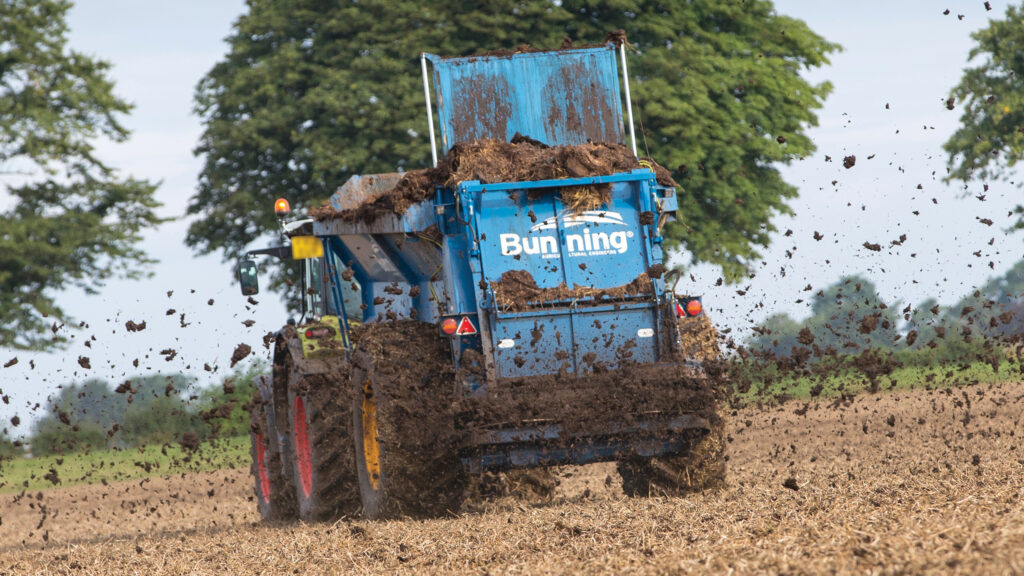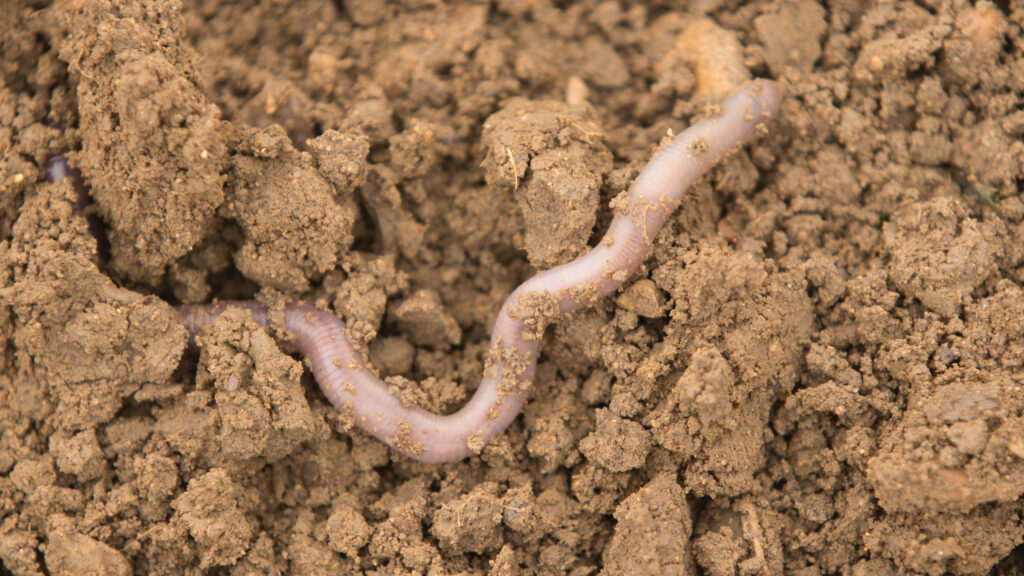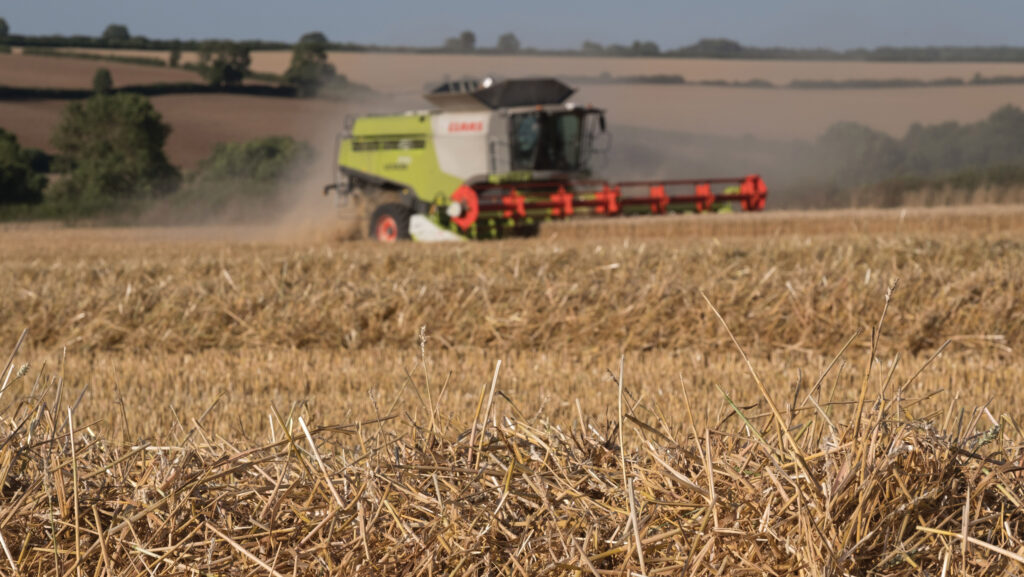How different forms of organic matter affect soil health
 Spreading cattle manure © GNP
Spreading cattle manure © GNP Building soil organic matter in arable soils is increasingly recognised as important for improving soil structure and water holding capacity, reducing nutrient leaching and providing greater resilience.
It is also key for carbon sequestration, which can open opportunities for possible payments through carbon schemes.
But how that organic matter is built is crucial for its stability in the soil and whether levels in the soil will be long-lasting, says Joel Williams, soil health educator and consultant of Integrated Soils.
See also: Trial reveals cost of unnecessary soil cultivations
“In farming, we traditionally talk about soil organic matter as if it is one thing,” he says.
“But in the soil, it is made up of many different things – some large and complex, some small and simple – and it has many different qualities.”
Some of the organic carbon that chemically makes up about 58% of organic matter, typically, can be very stable, while in other forms, it can be highly available and digestible.
Part of the difference is whether the organic matter has been built primarily from plant material or whether it is coming from microbial activity, Joel says.
Types of organic matter
Some researchers break up soil organic matter into different types: particulate organic matter (POM) and mineral-associated organic matter (MAOM).
Decaying plant material – such as from high carbon-to-nitrogen ratio “brown material” – cannot be absorbed directly by microbes.
“They have to digest it first – so they secrete digestive enzymes, which are kind of like scissors, breaking complex material into smaller and smaller pieces before it can be absorbed,” Joel explains.
Earthworms and other organisms also play a role in this decomposition. This decomposing of more complex plant material is particulate organic matter.
In contrast, simpler carbon compounds – including liquid carbon exudates from plants and very low carbon-to-nitrogen ratio material – can be ingested directly by microbes, helping to grow their biomass efficiently and rapidly.
“It’s highly digestible and, once ingested by microbes, becomes part of their bodies and of microbial origin.”
This is important because research has discovered that roughly 50% of organic matter is made up of dead microbial bodies, with the remainder from plant decay.
“Those microbial dead bodies have a particular affinity to stick to soil particles – particularly silts and clays – and form very stable organic matter. This is the mineral-associated organic matter.”

© Tim Scrivener
Ways to increase soil organic matter
- Minimise soil disturbance
- Maintain living roots in soils as much as possible, such as growing cover crops
- Don’t overdo nitrogen fertiliser
- Cropping diversity: perennial plants allocate more carbon below ground
- Add organic amendments, such as compost – this is the most effective way to increase soil organic matter being already stabilised
- Livestock have a role by processing organic matter to make it more digestible for microbes and trampling ground
Soil type
Clay soils form more of this type of organic matter than sandy soils because there are more mineral surfaces for carbon to bind with.
Higher calcium levels will also help by forming a bridge for the carbon to bind with clay particles.
However, because there is a finite number of mineral surfaces to bind to in all soil, this type of organic matter will plateau eventually.
In contrast, particulate organic matter does not appear to saturate, Joel says.
“The perfect example is a peat bog, where it has plants growing and dying year after year, forming particulate organic matter.
“You can build lots of that quality of carbon. But once that environment is disturbed, it is very prone to being lost because it is not chemically attached to soil particles.
“It’s the stability of mineral-associated organic matter that makes it better for soil carbon sequestration, he continues. “There’s no sequestration without stabilisation,” he says.
Mineral association is one of two key mechanisms to stabilise carbon inputs coming into the soil. “The second is a physical process, where carbon is trapped within soil aggregates.
“When soil aggregates – soil particles that are clumped together partly through the glue-like substance released by microbes – any carbon inside gets physically trapped and protected.
“This can be either particulate organic matter or mineral-associated organic matter.”
Soil disturbance breaks up those aggregates, releasing the carbon, notes Joel, which is why “minimising disturbance” is a key principle that growers looking to build stable organic matter should follow.
Living roots
Maintaining living roots in soils as much as possible is also fundamental to building organic matter.
Researchers have found that growing cover crops increases soil organic carbon by about 15% on average in clay soils, for example.
Diversity of cover crop species has also been found to increase both root carbon and overall soil organic carbon.
“It’s primarily the roots that drive the building of soil organic matter,” Joel says.
Researchers have also found that root material is about five times more likely to form stable soil organic matter than shoot material.
This is partly due to the root exudates that are more easily digested and converted to mineral-associated organic matter, as well as the carbon used to produce root biomass by the plant.
In addition, rooting depth helps with stabilisation of carbon deposits.
“It’s surface carbon that is much more likely to cycle.
“If we can get carbon – particularly liquid carbon exudates that form mineral-associated organic matter – down to depth with deep-rooted plants, it is more protected from oxygen and some of that cycling,” he says.
Practically, maximising soil organic carbon is a mix between optimising plant growth and photosynthesis and driving the microbial processes below ground, he suggests.
“Maximising photosynthesis will be through optimising the key nutrients that drive the process, and using a diverse range of plants to drive it.
“And then as carbon comes down into the soil, we want to prime microbial digestion.
“The key to that is a combination of the litter material from the plant, plus the green cover root – the living roots – exudates to feed the micro-organisms to help form the stabilised carbon within aggregates or attached to mineral surfaces,” he says.
Why higher crop yields don’t always lead to more soil organic carbon
In theory, building soil organic matter should be optimising plant growth, including crops. T
he more photosynthetic biomass produced, the more carbon entering the soil, and therefore, more soil organic carbon.
But the reality is a little more nuanced, Joel says, with soil carbon decreasing over the past 50 years with intensive agriculture.
There are at least three reasons, not including cultivation, why increased biomass isn’t contributing to more soil organic carbon, he says.
The first is the historical shift from perennial plants to annuals.
“Perennial plants allocate more carbon below ground, to the roots, to store energy, which they draw from to regrow,” Joel says.
“An annual plant’s primary focus is to produce above-ground biomass, flower and to produce seed, so they don’t invest so much in root growth.
“Switching from perennial to annual crops drives less root biomass and, therefore, less carbon from the roots.”
Breeding has also played a role – again, through selecting crops that allocate more carbon to the above-ground biomass that drives yield.
“It’s a trade-off because that comes at a cost of root biomass.”
The third reason is nitrogen fertilisation.
“Nitrogen is a very good nutrient to build and drive yield – it does this by increasing above-ground biomass, but has less effect on the below-ground biomass.”
It is a complicated picture, Joel stresses. “Initially, as nitrogen fertilisation increases, there is some increase in root biomass, but then it reaches a plateau.
“And unlike the yield plateau – which stabilises as nitrogen increases – it actually decreases or suppresses root growth and biomass production.
“So when we overdo nitrogen, it will have a suppressive effect on our ability to build soil organic matter,” he says.

Harvesting winter wheat © Tim Scrivener
What about organic amendments and livestock integration?
Adding organic amendments, such as compost, is perhaps the most effective method of increasing soil organic matter, Joel says.
“Composting is a special process as it’s already gone through a microbial transformation, so it has already been stabilised.
“The negative is the material has come from somewhere else, and generally there isn’t enough to be treating every hectare with it.”
Livestock also plays an important role in processing plant material, making it more digestible for micro-organisms to convert into mineral-associated organic matter.
Researchers found excluding animals in a split-field trial led to lower below-ground carbon allocation, root biomass and root exudates, which all lead to lower soil organic carbon levels, Joel says.
Another UK study found that stopping grazing strongly decreased microbial and other soil fauna diversity.
And a third study found that trampling helped increase access to plant litter on the soil surface for microbes.
“In this study, they showed increases in soil organic matter from a little bit of animal trampling,” Joel notes.
- Joel Williams was speaking at Groundswell 2024.

